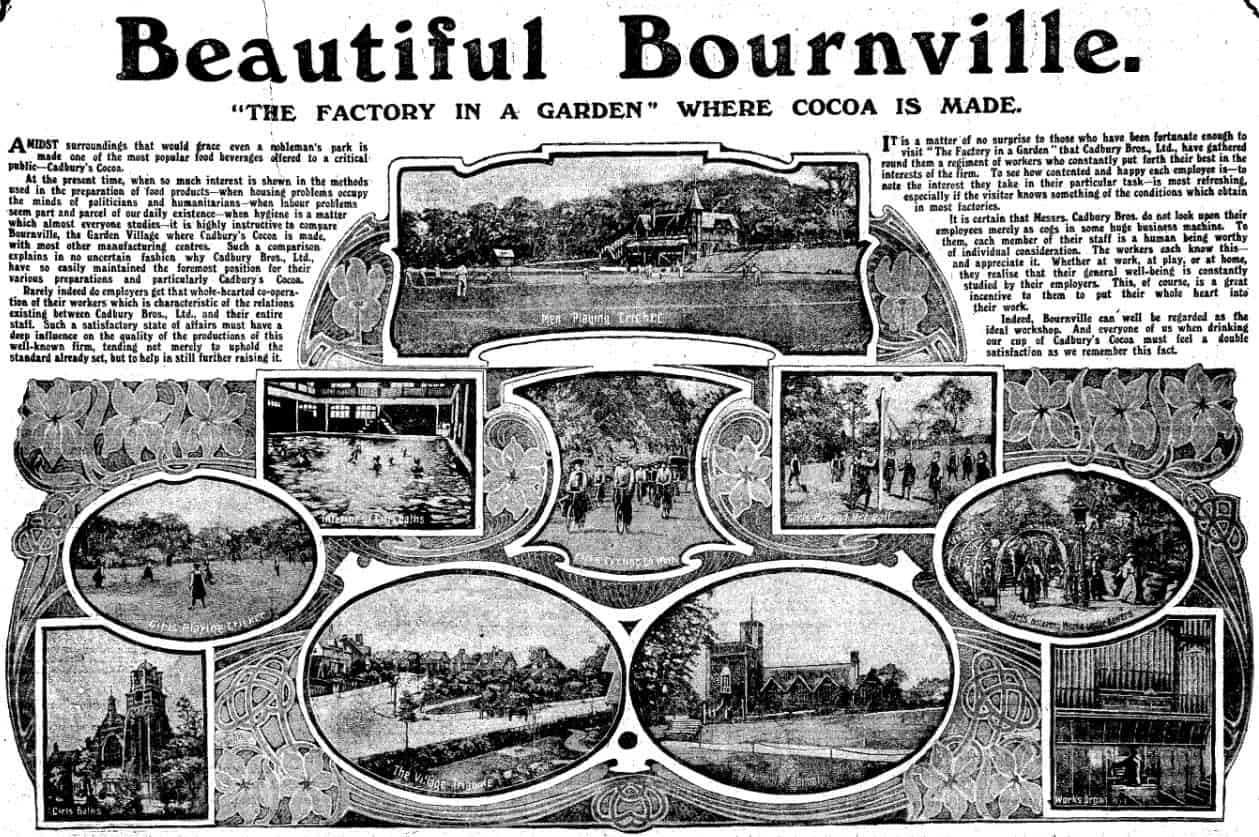By Lily Cratchley, Gale Ambassador at the University of Birmingham
Located just a ten-minute walk from Birmingham’s most populous student housing area, Selly Oak, the village of Bournville – one of the first model villages in England – stands as a rare chunk of living history within the bustling city. Efforts to preserve the charm and wellbeing of the village are organised by volunteers, while the old chocolate factory has been transformed into a tourist attraction named after the man who envisioned and created the beauty of Bournville, ‘Cadbury World’.

This post will employ Gale’s archives to help construct a history of this model village evidencing its unique spirit and remarkable beauty.
Myra’s Journal of Dress and Fashion, a nineteenth-century British periodical, was one of the first publications to document the wonders of Bournville. In 1880, just two years after George Cadbury bought the land that would become this model village, the journal published an article on Cadbury’s production of cocoa. The steps of cocoa manufacture are detailed alongside the unique and inspiring conditions in which the cocoa was made; the village of Bournville is characterised as ‘a charming valley surrounded by woods and hills,’ ensuring the cocoa was ‘made in locality where the air is pure and untainted.’

A model village is defined as a place which provides a high standard of housing, typically built by an employer for their workforce. By this definition, Bournville cannot truly be considered a model village until 1893, when George Cadbury made plans to start building houses for his workers, despite the factory having been founded in 1879. The article above, however, shows that plans to support his workers by providing housing were in the works long before 1893. It also shows that this stemmed from earlier attempts to create a community feel among the factory workers through both religion – ‘each day before work begins all assemble for a short religious service,’ and recreation – ‘a large enclosed flower-garden is reserved for the use of the women and girls… and the men and boys are provided with…an open-air swimming bath in the rear of the grounds.’

Four years after this article was published in Myra’s Journal, an article titled ‘Bournville the “Cocoa Town”’ made local newspapers across the country, including in cities such as Leicester, Leeds and Bangor. In contrast to the 1880 article which focused on the manufacturing of cocoa, this 1884 article concentrated on the admirable attention payed to workers’ wellbeing in Bournville village. The ‘roving correspondent’ noted that not only was ‘the evident desire displayed by the firm to contribute in ways many and various…to the comfort, happiness, health and well-being of the workpeople’ marvellously rare, the village itself had that same charm in its very air, which was filled with ‘the strong, permeating, ever present and pleasant odour, as of freshly-poured-out chocolate, such as the strike the olfactory senses on entering a Spanish or Italian café abroad.’ It was later added that the prosperous village was also inhabited by ‘merry’ workers whose ties were ‘dearer and closer than the mere common bond between employees,’ concluding with the statement that the model village itself, just four years old at the time, was ‘most certainly… one of the wonders of England.’

By 1896, another article in Myra’s Journal, labelled the village a ‘remarkable and happy little colony’ with ‘exceptional’ working conditions. Photographs in this newspaper helped to relay the cleanliness of the village and the additional institutions built to maintain support for its workers, including ‘a sick society, orchestral society and technical schools.’

News of Cadbury’s model village made the Daily Mail in 1907, with an illustrated article entitled ‘Beautiful Bournville,’ depicting ‘“The Factory in a garden” where cocoa is made.’ Photographs of the cricket grounds, village shops and even the girls’ baths paint a picture of the ‘purity’ which George Cadbury aimed to establish throughout Bournville.

The village, itself, in comparison to the 1880 article, is described as ‘bright and ‘sunlit’ with ‘wide roads and open spaces, neat, attractively built cottages, and workers as happy as the day is long,’ evidencing that Cadbury’s vision of ‘beauty’ was able to transcend decades.
It is interesting to inspect Bournville in the present day. Visiting the peaceful, pretty village and leaving behind our frantic university life, was a welcome experience for my friends and I this December. My own photographs, included here, depict the current look of the village. While much has changed since the era of George Cadbury, including the closing of the primary school and renovating of the ‘Rest House,’ which is now an information centre, it is comforting to know that many of Cadbury’s conceptualised features of the village still remain; the greenery of the village is charming and well-kept, whilst a keen community spirit is maintained through merry inhabitants, the addition of a row of village shops, and the assembling of an impressive, colourful Christmas tree. Above all, it was quite astonishing how, even centuries after the ‘roving correspondent’s’ visit to Bournville, we too were met on arrival with air that held an ‘ever present and pleasant odour, as of freshly-poured-out chocolate.’
All photos are author’s own.


